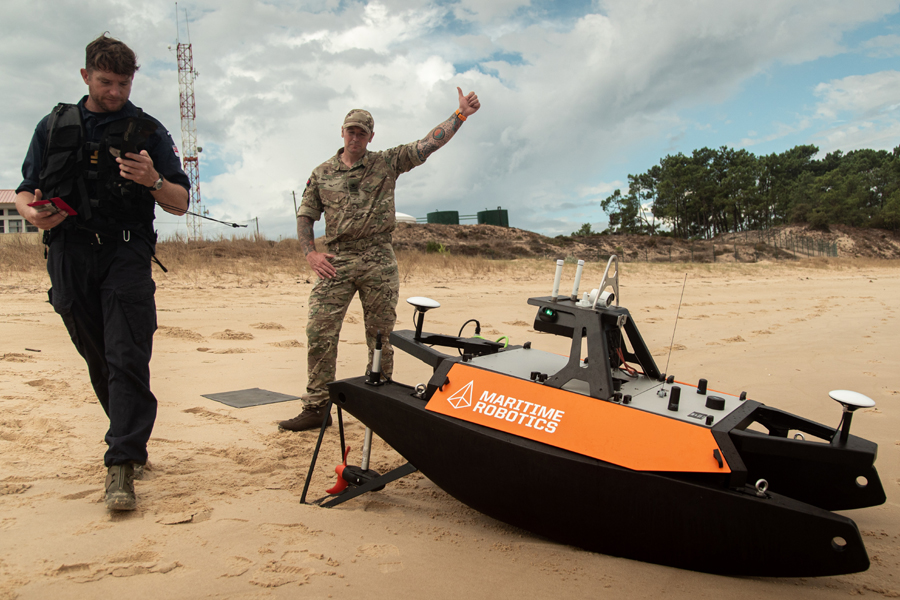
Unmanned air, surface and underwater vehicles were deployed at sea during a recent multinational exercise in Portugal called REPMUS 21.
~
NATO has participated in a major exercise involving unmanned underwater, surface and air vehicles.
Exercise REP(MUS) 21 is an annual exercise jointly organised by the Portuguese Navy, the University of Porto, NATO’s Centre for Maritime Research and Experimentation (CMRE) and the NATO Maritime Unmanned Systems Initiative. The exercise gives Allies and partners a chance to field and evaluate new maritime technologies. REP(MUS) stands for ‘Robotic Experimentation and Prototyping augmented by Maritime Unmanned Systems’.
This NATO Multimedia footage, captured mid-September around Tróia and Sesimbra, includes shots of various unmanned vehicles in and out of the water and soundbites with experts from Portugal and NATO’s Maritime Unmanned Systems Initiative.
Shot list:-
- (00:00) Flags on display near the entrance of Tróia naval base in Portugal
- (00:03) A Spanish navy unmanned boat performing test drives at a naval base in Tróia, Portugal
- (00:10) A UK unmanned vehicle called the OTTER on the beach in Tróia, Portugal
- (00:13) A UK Royal Navy bomb disposal expert preparing and launching the OTTER unmanned surface vehicle in Tróia, Portugal
- (00:24) The OTTER unmanned surface vehicle at sea
- (00:27) A UK Royal Marines Commando and an expert from the UK Royal Navy controlling the OTTER unmanned surface vehicle
- (00:38) the OTTER unmanned surface vehicle being recovered
- (00:51) Operations Centre at Tróia naval base in Portugal
- (01:10) The Royal Netherlands navy preparing, launching and flying an acecore zoe unmanned aerial vehicle
- (01:35) Row of ACECORE NEO unmanned aerial vehicles on ground
- (01:37) The Royal Netherlands Navy preparing, launching and recovering ACECORE NEO unmanned aerial vehicles
- (02:26) The UK Royal Navy preparing the unmanned surface vessel MADFOX for operations at Tróia naval base in Portugal
- (03:01) The UK Royal Navy controlling unmanned surface vessel MADFOX from the operations centre at the naval base in Tróia
- (03:11) Spanish unmanned surface vehicle VENDAVAL being launched into the water and commencing operations at Tróia naval base in Portugal
- (03:39) The Italian Mine Countermeasures Forces command squad carrying and then opening a hard case with REMUS unmanned underwater vehicle
- (03:55) REMUS unmanned underwater vehicle
- (04:02) Sonar image from REMUS unmanned underwater vehicle
- (04:05) At the REP(MUS) operations centre in Sesimbra, Portugal
- (04:14) German Navy Marines recover an autonomous underwater vehicle in the Atlantic ocean off Sesimbra in Portugal
- (04:20) German Navy research vessel PLANET in the Atlantic ocean off Sesimbra in Portugal
- (04:24) A German flag on research vessel PLANET
- (04:27) Captain of the German Navy research vessel PLANET controlling the vessel
- (04:33) Camera of the SEACAT autonomous underwater vehicle
- (04:37) German Navy research vessel PLANET crew launching a SEACAT autonomous underwater vehicle into the Atlantic ocean off Sesimbra in Portugal
- (04:47) SEACAT autonomous underwater vehicle in the Atlantic ocean off Sesimbra in Portugal
- (05:01) German Navy research vessel PLANET crew recover a SEACAT autonomous underwater vehicle
- (05:40) Soundbite – Sean Trevethan, Director, NATO Maritime Unmanned Systems Innovation and Coordination Cell
~



















